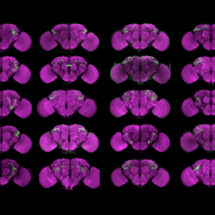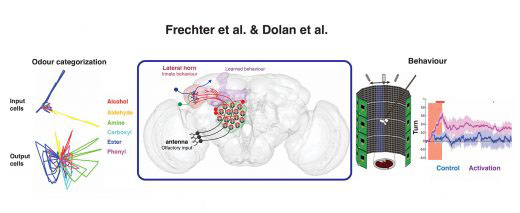
We, and all animals, sense things in our surroundings and react to them, but how a sensory input reaching the brain is transformed into behaviour is still unknown for all but the most simple reflexes. To better understand this, Greg Jefferis’ group in the LMB’s Neurobiology Division in collaboration with researchers at the Janelia Research Campus have performed the first deep and comprehensive functional analysis into the innate odour processing pathway of a behaviourally complex animal, the vinegar fly.
In two back-to-back publications, Shahar Frechter, Michael-John Dolan, and Alexander Bates from Greg’s group have used a genetic technique to label neurons in the fly brain enabling each to be individually mapped, recorded from, and optogenetically manipulated, in order to study their function. The team were able to identify and define more than 160 different neuronal cell types confined within a higher brain area responsible for innate responses to smells, known as the lateral horn. This is a remarkable diversity of cell types for such a small brain area – similar numbers have recently been reported for the whole mouse cortex – about a million times larger. This initial cell typing was based on genetic and anatomical approaches, but recording the activity of neurons in live flies showed that cell types showed consistent sensory responses across animals.
In addition, they developed genetic tools to allow more than 80 of these neuron types to be functionally manipulated, for example using optogenetics. This involves genetically engineering flies to make specific brain neurons light sensitive: shining a red light on the fly can then activate these specific neurons and change behaviour. Some neurons drove positive approach behaviour, while others signalled that a particular odour should be avoided. Importantly, the researchers found that the same neuron type drove the same response in different animals. This represents a fundamental difference between the lateral horn and the brain region responsible for learned responses to smells, where the function of neurons differs between animals as it is shaped by learning.
Interestingly, the researchers were able to see that the neuronal coding of responses to smells is more complicated than previously thought: many neurons did not code for simple attraction or avoidance behaviour. Neurons within the lateral horn received signals from multiple different sensory neurons enabling improved categorisation of different types of odours. This should allow flies to respond differently to different types of positive or negative stimuli without learning. For example, different responses would be required for detection of a predator and detection of food that has spoiled.

Together these studies lay the groundwork for a better understanding of the circuits that drive behaviour. This should be translatable to future study of similar processes in larger brains including our own, as basic mechanisms of processing sensory information into complex behaviours are likely to be shared.
The work was funded by the MRC, ERC, Wellcome Trust, Boehringer Ingelheim Fonds, Howard Hughes Medical Institute, EMBO, and a Herchel Smith Studentship.
Further references:
Neurogenetic dissection of the Drosophila lateral horn reveals major outputs, diverse behavioural functions, and interactions with the mushroom body. Dolan, M-J., Frechter, S., Bates, AS., Dan, C., Huoviala, P., Roberts, RJV., Schlegel, P., Shawan, S., Tabano, R., Dionne, H., Christoforou, C., Close, K., Sutcliffe, B., Giuliani, B., Feng, L., Costa, M., Ihrke, G., Meissner, G., Bock, D., Aso, Y., Rubin, GM., Jefferis, GSXE. eLife
Functional and anatomical specificity in a higher olfactory centre. Frechter, S., Bates, AS., Tootoonian, S., Dolan, M-J., Manton, JD., Jamasb, A., Kohl, J., Bock, D., Jefferis, GSXE. eLife
Greg’s group page
Janelia Research Campus
Previous Insight on Research: Instinctive and learned responses to smells are controlled by a single brain circuit in flies